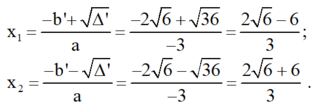
Hãy nhập câu hỏi của bạn vào đây, nếu là tài khoản VIP, bạn sẽ được ưu tiên trả lời.


\(5x^4+y^2-4x^2y-85=0\)
\(\Leftrightarrow x^4=4x^2-4x^2y+y^2-85=0\)
\(\Leftrightarrow x^4+\left(2x^2-y\right)^2=85\)
\(\Leftrightarrow x^4\in\left\{3^4;2^4;1^4;0^4\right\}\)
tiếp tục xét lần lượt các trường hợp:
+) nếu \(x^4=0^4\Rightarrow x=0\Rightarrow y^2=85\Rightarrow y\in\varnothing\)
+) nếu \(x^4=1^4\Rightarrow x=\pm1\Rightarrow\left(y-2\right)^2=84\Rightarrow y\in\varnothing\)
+) nếu \(x^4=2^4\Rightarrow x=\pm2\Rightarrow\left(y-8\right)^2=69\Rightarrow x\in\varnothing\)
+) nếu \(x^4=3^4\Rightarrow x=\pm3\Rightarrow\left(y-18\right)^2=2^2\)
\(\Leftrightarrow\orbr{\begin{cases}y-18=2\\y-18=-2\end{cases}\Leftrightarrow\orbr{\begin{cases}y=20\\y=16\end{cases}}}\)( nhận )
P/s nhận cả hai nhé

a) Thay m=3 vào pt ta được:
\(9x+6=4x+9\Leftrightarrow x=\dfrac{3}{5}\)
Vậy...
b) Thay x=-1,5 vào pt ta được:
\(m^2\left(-1,5\right)+6=4.\left(-1,5\right)+3m\)
\(\Leftrightarrow\dfrac{-3}{2}m^2-3m+12=0\)\(\Leftrightarrow\left[{}\begin{matrix}m=2\\m=-4\end{matrix}\right.\)
Vậy...
c)Pt \(\Leftrightarrow x\left(m^2-4\right)=3m-6\)
Để pt vô nghiệm \(\Leftrightarrow\left\{{}\begin{matrix}3m-6\ne0\\m^2-4=0\end{matrix}\right.\)\(\Leftrightarrow\left\{{}\begin{matrix}m\ne2\\m=\pm2\end{matrix}\right.\)\(\Rightarrow m=-2\)
Để pt có vô số nghiệm \(\Leftrightarrow\left\{{}\begin{matrix}3m-6=0\\m^2-4=0\end{matrix}\right.\)\(\Leftrightarrow\left\{{}\begin{matrix}m=2\\m=\pm2\end{matrix}\right.\)\(\Rightarrow m=2\)
d)Để pt có nghiệm \(\Leftrightarrow m^2-4\ne0\Leftrightarrow m\ne\pm2\)
\(\Rightarrow x=\dfrac{3m-6}{m^2-4}=\dfrac{3\left(m-2\right)}{\left(m-2\right)\left(m+2\right)}=\dfrac{3}{m+2}\)
Để \(x\in Z\Leftrightarrow\dfrac{3}{m+2}\in Z\)
Vì \(m\in Z\Leftrightarrow m+2\in Z\).Để \(\dfrac{3}{m+2}\in Z\Leftrightarrow m+2\inƯ\left(3\right)=\left\{-1;-3;1;3\right\}\)
\(\Leftrightarrow m=\left\{-3;-5;-1;1\right\}\) (tm)
Vậy...

\(\text{Δ}=\left(2m-1\right)^2-8\left(m-1\right)\)
\(=4m^2-4m+1-8m+8\)
\(=4m^2-12m+9=\left(2m-3\right)^2\)
Để phương trình có hai nghiệm phân biệt thì 2m-3<>0
hay m<>3/2
Theo đề, ta có hệ phương trình:
\(\left\{{}\begin{matrix}3x_1-4x_2=11\\x_1+x_2=\dfrac{-2m+1}{2}\end{matrix}\right.\Leftrightarrow\left\{{}\begin{matrix}3x_1-4x_2=11\\2x_1+2x_2=-2m+1\end{matrix}\right.\)
\(\Leftrightarrow\left\{{}\begin{matrix}3x_1-4x_2=11\\4x_1+4x_2=-4m+2\end{matrix}\right.\Leftrightarrow\left\{{}\begin{matrix}7x_1=-4m+13\\4x_2=3x_1-11\end{matrix}\right.\)
\(\Leftrightarrow\left\{{}\begin{matrix}x_1=\dfrac{-4m+13}{7}\\4x_2=\dfrac{-12m+36}{7}-\dfrac{77}{7}=\dfrac{-12m-41}{7}\end{matrix}\right.\)
\(\Leftrightarrow\left\{{}\begin{matrix}x_1=\dfrac{-4m+13}{7}\\x_2=\dfrac{-12m-41}{28}\end{matrix}\right.\)
Theo Vi-et, ta được: \(x_1x_2=\dfrac{m-1}{2}\)
\(\Leftrightarrow\dfrac{\left(4m-13\right)\left(12m+41\right)}{196}=\dfrac{m-1}{2}\)
\(\Leftrightarrow\left(4m-13\right)\left(12m+1\right)=98\left(m-1\right)\)
\(\Leftrightarrow48m^2+4m-156m-13-98m+98=0\)
\(\Leftrightarrow48m^2-250+85=0\)
Đến đây bạn chỉ cần giải pt bậc hai là xong rồi
\(\Delta=\left(2m-1\right)^2-8\left(m-1\right)=4m^2-12m+10\)
\(=\left(2m-3\right)^2+1>0\)
Vậy pt có 2 nghiệm pb
Theo Vi et \(\left\{{}\begin{matrix}x_1+x_2=\dfrac{1-2m}{2}\left(1\right)\\x_1x_2=\dfrac{m-1}{2}\left(2\right)\end{matrix}\right.\)
Ta có \(3x_1-4x_2=11\left(3\right)\)
Từ (1) ; (3) ta có hệ \(\left\{{}\begin{matrix}4x_1+4x_2=2-4m\\3x_1-4x_2=11\end{matrix}\right.\Leftrightarrow\left\{{}\begin{matrix}7x_1=13-4m\\x_2=\dfrac{1-2m}{2}-x_1\end{matrix}\right.\Leftrightarrow\left\{{}\begin{matrix}x_1=\dfrac{13-4m}{7}\\x_2=\dfrac{1-2m}{2}-\dfrac{13-4m}{7}\end{matrix}\right.\)
\(x_2=\dfrac{7-14m-26+8m}{14}=\dfrac{-19-6m}{14}\)
Thay vào (2) ta được \(\left(\dfrac{13-4m}{7}\right)\left(\dfrac{-19-6m}{14}\right)=\dfrac{m-1}{2}\)
\(\Leftrightarrow m=4,125\)

a, \(x^4-4x^3-6x^2-4x+1=0\)(*)
<=> \(x^4+4x^2+1-4x^3-4x+2x^2-12x^2=0\)
<=> \(\left(x^2-2x+1\right)^2=12x^2\)
<=>\(\left(x-1\right)^4=12x^2\) <=> \(\left[{}\begin{matrix}\left(x-1\right)^2=\sqrt{12}x\\\left(x-1\right)^2=-\sqrt{12}x\end{matrix}\right.\)<=> \(\left[{}\begin{matrix}x^2-2x+1-\sqrt{12}x=0\left(1\right)\\x^2-2x+1+\sqrt{12}x=0\left(2\right)\end{matrix}\right.\)
Giải (1) có: \(x^2-2x+1-\sqrt{12}x=0\)
<=> \(x^2-2x\left(1+\sqrt{3}\right)+\left(1+\sqrt{3}\right)^2-\left(1+\sqrt{3}\right)^2+1=0\)
<=> \(\left(x-1-\sqrt{3}\right)^2-3-2\sqrt{3}=0\)
<=> \(\left(x-1-\sqrt{3}\right)^2=3+2\sqrt{3}\) <=> \(\left[{}\begin{matrix}x-1-\sqrt{3}=\sqrt{3+2\sqrt{3}}\\x-1-\sqrt{3}=-\sqrt{3+2\sqrt{3}}\end{matrix}\right.\) <=> \(\left[{}\begin{matrix}x=\sqrt{3+2\sqrt{3}}+\sqrt{3}+1\left(ktm\right)\\x=-\sqrt{3+2\sqrt{3}}+\sqrt{3}+1\left(tm\right)\end{matrix}\right.\)
=> \(x=-\sqrt{3+2\sqrt{3}}+\sqrt{3}+1\)
Giải (2) có: \(x^2-2x+1+\sqrt{12}x=0\)
<=> \(x^2-2x\left(1-\sqrt{3}\right)+\left(1-\sqrt{3}\right)^2-\left(1-\sqrt{3}\right)^2+1=0\)
<=> \(\left(x+\sqrt{3}-1\right)^2=3-2\sqrt{3}\) .Có VP<0 => PT (2) vô nghiệm
Vậy pt (*) có nghiệm x=\(-\sqrt{3+2\sqrt{3}}+\sqrt{3}+1\)

a) \(2x^2-5x+1=0\)
\(\Delta=b^2-4ac\Rightarrow\left(-5\right)^2-4.2.1=17>0\)
Phương trình có 2 nghiệm phân biệt:
\(x_1=\dfrac{-b+\sqrt{\Delta}}{2a}=\dfrac{-\left(-5\right)+\sqrt{17}}{2.2}=\dfrac{5+\sqrt{17}}{4}\)
\(x_2=\dfrac{-b-\sqrt{\Delta}}{2a}=\dfrac{-\left(-5\right)-\sqrt{17}}{2.2}=\dfrac{5-\sqrt{17}}{4}\)
___________________________________________________
b) \(4x^2+4x+1=0\)
\(\Delta=b^2-4ac\Rightarrow4^2-4.4.1=0\)
Vậy phương trình có nghiệm kép:
___________________________________________________
c) \(5x^2-x+2=0\)
\(\Delta=b^2-4a\Rightarrow\left(-1\right)^2-4.5.2=-39\)
Vậy phương trình vô nghiệm.

4x2 – 4x + 1 = 0;
a = 4; b = -4; c = 1
Δ = b2 - 4ac = (-4)2 - 4.4.1 = 16 - 16 = 0
⇒ phương trình có nghiệm kép
x = (-b)/2a = (-(-4))/2.4 = 1/2
Vậy phương trình có nghiệm duy nhất x = 1/2



a) Phương trình bậc hai 4 x 2 + 4 x + 1 = 0
Có a = 4; b’ = 2; c = 1; Δ ’ = ( b ’ ) 2 – a c = 2 2 – 4 . 1 = 0
Phương trình có nghiệm kép là:

b) Phương trình 13852 x 2 – 14 x + 1 = 0
Có a = 13852; b’ = -7; c = 1;
Δ ’ = ( b ’ ) 2 – a c = ( - 7 ) 2 – 13852 . 1 = - 13803 < 0
Vậy phương trình vô nghiệm.
c) Phương trình bậc hai 5 x 2 – 6 x + 1 = 0
Có: a = 5; b’ = -3; c = 1.; Δ ’ = ( b ’ ) 2 – a c = ( - 3 ) 2 – 5 . 1 = 4 > 0
Phương trình có hai nghiệm phân biệt:

d) Phương trình bậc hai: ![]()

Phương trình có hai nghiệm phân biệt :

Kiến thức áp dụng
Phương trình ax2 + bx + c = 0 (a ≠ 0) có biệt thức Δ = b2 – 4ac.
+ Nếu Δ > 0, phương trình có hai nghiệm phân biệt 
+ Nếu Δ = 0, phương trình có nghiệm kép  ;
;
+ Nếu Δ < 0, phương trình vô nghiệm.
272hay 27y2
272